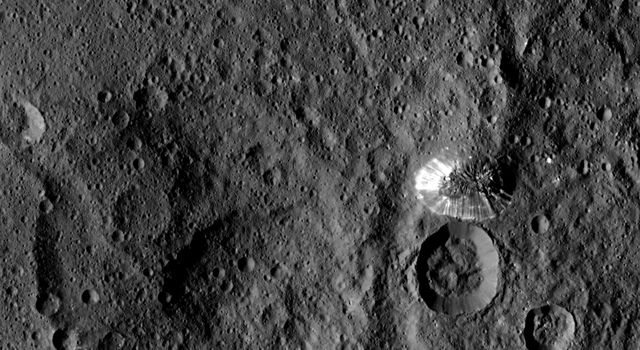Dawn probe has been studying Ceres for a year now: interesting discoveries and new puzzles

On March 6, 2015, the Dawn probe went into the orbit of Ceres, the largest body in the asteroid belt. Since then, the spacecraft has sent a lot of photos and scientific data about Ceres. Dawn is something like an “asteroid belt window” through which earth scientists are looking at objects away from it.
Ceres does not stint on surprises. So, it has long been known that there are bright spots on the surface of a planetoid. The probe photographed them in detail, and the situation cleared, the scientists explained the nature of the spots. But now another interesting mystery has appeared - a five-kilometer mountain with bright slopes.

If you look at the photo for a long time, it seems that this is not a mountain, but a pit with steep slopes (photo: NASA)
')
It is called Ahuna Mons . From a distance of 46,000 km, the mountain looked like a slight bulge, and it was not particularly noticed. But as Dawn approached the planetoid, it became clear that this was a pyramidal mountain with bright, smooth and steep slopes.

(photo: NASA)
The last photo of Ahuna Mons was taken from a distance of 120 times smaller than in February 2015. Scientists began to look for similar objects on the surface of Ceres, but it turned out that the mountain is the highest formation on a planetoid, similar in structure and size of objects there are no more.
“No one expected to see the mountain on Ceres, especially as big as Ahuna Mons. And we still do not have a satisfactory model for the formation of such a mountain, ”said Chris Russell, one of the leaders of the Dawn project.
As for the spots mentioned above, there were not two but more than ten of them in the crater of Occator. About 130 spots were counted on the entire planetoid, most of which are located near the impact craters. After analyzing the brightness and structure of the spots, it was concluded that this is not ice or salt, but something average . More precisely, a certain type of water magnesium sulfate - hexahydrite (Mg [SO4] 6H2O).

(photo: NASA)
There is also an assumption that this substance is a phyllosilicate rich in ammonia. In this case, Ceres was formed outside the solar system, or within the system, but from material that flew in from outside the solar system.
It is not clear from what the slopes of the mountain described above are composed, and whether this material is the same as the material of the spots. But Dawn continues to study Ceres, so that this mystery should be cleared up soon. New pictures and more detailed data will be presented by scientists on March 22, during a press conference in Woodlands, Texas.
Source: https://habr.com/ru/post/391409/
All Articles